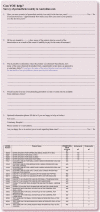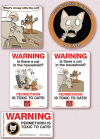Permethrin spot-on intoxication of cats Literature review and survey of veterinary practitioners in Australia
- PMID: 20123482
- PMCID: PMC10845477
- DOI: 10.1016/j.jfms.2009.12.002
Permethrin spot-on intoxication of cats Literature review and survey of veterinary practitioners in Australia
Abstract
SURVEY AIMS: A questionnaire was sent to veterinarians in Australia to determine the approximate number of cats presenting for permethrin spot-on (PSO) intoxication over a 2-year period.
Findings: Of the 269 questionnaires returned, 255 were eligible for analysis. A total of 207 respondents (81%) reported cases of PSO intoxication in cats over the previous 2 years. In total, 750 individual cases were reported, with 166 deaths. While all deaths were generally attributable to intoxication, 39 cats were euthanased because owners were unable to pay the anticipated treatment costs. Brands of PSO implicated included Exelpet Flea (and Tick) Liquidator (Mars Australia) (146 respondents), Bayer Advantix (48), Purina Totalcare Flea Eliminator Line-On (19), Troy Ease-On (six) and Duogard Line-On (Virbac) (four); 67 respondents were not able to identify a specific product. Permethrin spot-on formulations were most commonly obtained from supermarkets (146 respondents), followed by pet stores (43), veterinary practices (16), and a range of other sources including produce stores and friends. The majority of intoxication cases reported involved PSOs labelled for use in dogs with specific label instructions such as 'toxic to cats'. Owners applied these PSO products to their cats accidentally or intentionally. In some cases, exposure was through secondary contact, such as when a PSO product was applied to a dog with which a cat had direct or indirect contact.
Recommendations: In the authors' view, because of the likelihood of inappropriate use and toxicity in the non-labelled species, over-the-counter products intended for use in either dogs or cats must have a high margin of safety in all species. Furthermore, PSOs should only be available at points of sale where veterinary advice can be provided and appropriate warnings given. As an interim measure, modified labelling with more explicit warnings may reduce morbidity and mortality.
Copyright 2009 ESFM and AAFP. Published by Elsevier Ltd. All rights reserved.
Figures






Comment in
-
Permethrin and cats don't mix - call for action.J Feline Med Surg. 2010 Jan;12(1):2-3. doi: 10.1016/j.jfms.2009.12.001. J Feline Med Surg. 2010. PMID: 20123480 Free PMC article. No abstract available.
Similar articles
-
Feline permethrin toxicity: retrospective study of 42 cases.J Feline Med Surg. 2010 Feb;12(2):61-71. doi: 10.1016/j.jfms.2009.09.018. Epub 2009 Nov 7. J Feline Med Surg. 2010. PMID: 19897392 Free PMC article.
-
Permethrin toxicity in cats: a retrospective study of 20 cases.Aust Vet J. 2008 Jun;86(6):219-23. doi: 10.1111/j.1751-0813.2008.00298.x. Aust Vet J. 2008. PMID: 18498556
-
Clinical effects and outcome of feline permethrin spot-on poisonings reported to the Veterinary Poisons Information Service (VPIS), London.J Feline Med Surg. 2007 Aug;9(4):335-9. doi: 10.1016/j.jfms.2007.05.003. Epub 2007 Jul 12. J Feline Med Surg. 2007. PMID: 17627861 Free PMC article.
-
[Vigilance for veterinary medicinal products: reports of adverse reactions in the year 2012].Schweiz Arch Tierheilkd. 2013 Nov;155(11):613-20. doi: 10.1024/0036-7281/a000523. Schweiz Arch Tierheilkd. 2013. PMID: 24168771 Review. German.
-
Tick paralysis in dogs and cats in Australia: treatment and prevention deliverables from 100 years of research.Aust Vet J. 2020 Jan;98(1-2):53-59. doi: 10.1111/avj.12891. Epub 2019 Nov 24. Aust Vet J. 2020. PMID: 31762008 Review.
Cited by
-
Surface distribution of pyrethroids following topical application to veterinary species: Implications for lateral transport.J Vet Pharmacol Ther. 2021 Jan;44(1):1-10. doi: 10.1111/jvp.12907. Epub 2020 Sep 10. J Vet Pharmacol Ther. 2021. PMID: 32910498 Free PMC article. Review.
-
Conventional treatment of a metaldehyde-intoxicated cat with additional use of low-dose intravenous lipid emulsion.JFMS Open Rep. 2020 Aug 21;6(2):2055116920940177. doi: 10.1177/2055116920940177. eCollection 2020 Jul-Dec. JFMS Open Rep. 2020. PMID: 32913659 Free PMC article.
-
Preventing mosquito and tick bites: A Canadian update.Paediatr Child Health. 2014 Jun;19(6):326-32. Paediatr Child Health. 2014. PMID: 25332663 Free PMC article.
-
Disinfectant choices in veterinary practices, shelters and households: ABCD guidelines on safe and effective disinfection for feline environments.J Feline Med Surg. 2015 Jul;17(7):594-605. doi: 10.1177/1098612X15588450. J Feline Med Surg. 2015. PMID: 26101311 Free PMC article. Clinical Trial.
-
Permethrin and cats don't mix - call for action.J Feline Med Surg. 2010 Jan;12(1):2-3. doi: 10.1016/j.jfms.2009.12.001. J Feline Med Surg. 2010. PMID: 20123480 Free PMC article. No abstract available.
References
-
- Ray DE. Pesticides derived from plants and other organisms. In: Hayes WJ, Laws ER, eds. Handbook of pesticide toxicology, classes of pesticides. Vol 2. San Diego: Academic Press, 1991: 585–636.
-
- Bates N. Pyrethrins and pyrethroids. In: Campbell A, Chapman M, eds. Handbook of poisoning in dogs and cats. London: Blackwell Science, 2000: 42–5.
-
- Anadón A, Martínez-Larrañaga MR, Martínez MA. Use and abuse of pyrethrins and synthetic pyrethroids in veterinary medicine. Vet J 2009; 182: 7–20. - PubMed
-
- Hansen SR. Pyrethrins and pyrethroids. In: Peterson ME, Talcott PA, eds. Small animal toxicology. 2nd edn. St Louis: Elsevier Saunders, 2006: 1002–8.
-
- Whittem T. Pyrethrin and pyrethroid insecticide intoxication in cats. Compend Contin Educ Pract Vet 1995; 17: 489–92.
Publication types
MeSH terms
Substances
LinkOut - more resources
Full Text Sources
Other Literature Sources
Research Materials
Miscellaneous

